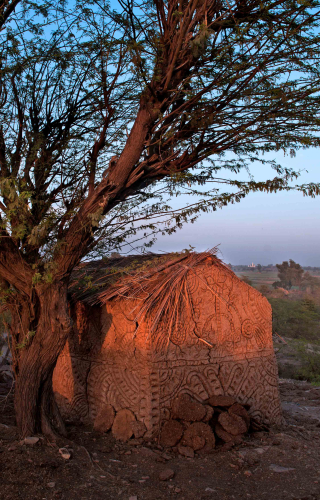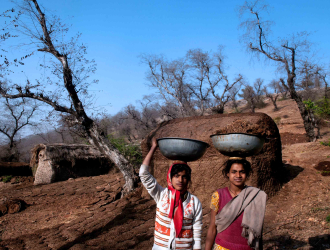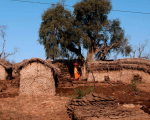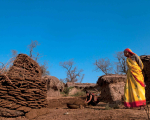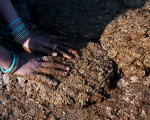As a photojournalist living and working in urban India, I feel rural India remains elusive in our understanding. The gap between the countryside and the city is a few dozen kilometers by geographical distance, but the intellectual disconnect is far wider. Rural practices are far more sustainable, rooted and self-sufficient, compared to complex systems in cities which are inefficient, resource-consuming and a relic of colonial practices. I came to know about one such rural practice, locally called chipri, while chatting with our office driver, Umesh Yadav, who hails from Uttar Pradesh.
Umeshji was driving me on an assignment to cover the story of sudden increase in price of LPG gas, around 2010, and its effect on middle-class families. At that time, there was no subsidy provided to LPG users in India. While discussing the topic of LPG, he told me it won’t affect village life of UP because they use cow- and/or buffalo-dung cake to fire the chulha (hearth). These dung cakes are stored in specially built huts called chipri. I was intrigued to know more, and planned to visit Umeshji’s native village, Chiksoli, in Agra division.
During my field visit, I travelled mostly through villages in western Uttar Pradesh. This region is part of Brajbhoomi, the sacred land of Lord Krishna’s childhood. Agrarian communities of Braj have deep veneration for gau (cow) and gobar (cow dung), both considered sacred and valued as dhan (wealth).This symbolic wealth is stored in chipri, hence this too is considered sacred. In some villages, the chipri is built just outside the village,usually in a grove, which gives protection during monsoon. In some cases, when the chipri is made on open ground, a thatched roof is added. Though they might look like a regular village home from a distance, a distinguishing feature is the designs made by women with their hands on the walls of the chipri huts.
Women members of a family, including little girls, come together to build the chipri. They also share responsibility of maintaining it. Men don’t involve themselves in this task. The entire chipri is constructed of cow or buffalo dung. Collection of dung is also the responsibility of women. The primary purpose of the chipri is to store dry dung cakes used for cooking. One fully stacked chipri can provide 2000–3000 dung cakes, almost a year-long supply for a large family. After the dung is exhausted, the dilapidated chipri is abandoned and a new one built.
Chipri is a valuable resource and every household in the village maintain their own chipri. Dung cakes are cheap, energy efficient and readily available from domestic livestock. Furthermore, dung cakes lower dependence on wood for fuel, which help protect local forest cover and save foraging time. It also provides a safe means for disposal of animal excreta, which can be substantial if not cleared on a daily basis. Some families maintain multiple chipris, depending on usage and amount of livestock owned.
In rural India, applying cow dung on floors, doorsteps and walls is a common practice as it is believed that cow dung insulates the structure, keeping it warm in winters and cold in summers. Dung cake is an essential ingredient in yajna (sacred fire) and used in rituals during Chhath Puja, when it is sold in markets priced between INR 20 to 50 per piece. Cow dung also has great value during Govardhan Puja, held in Brajbhoomi at Mount Govardhan, which according to mythology was raised by Lord Krishna to protect villagers and cattle of Gokul from torrential rains unleashed by Lord Indra. Govardhan puja is one in a sequence of various rituals connected to a specific day during the five-day celebration of Diwali. On the occasion of Govardhan Puja, women make anthropomorphic sculptures from cow dung at the entrance of their homes as harbingers of good luck. they then offer puja to the dung figures, and a cow is taken from the shed and made to cross the doorstep and bless the Govardhan by trampling on it. Eleven days later, on the auspicious lunar day of ekadeshi, women sweep the dried cow dung figures aside and decorate the spot with a swastika or rangoli. Two days later, at full moon, women carry the dried-up cow dung to the fields to scatter it as blessed manure.
Umesh had told me that food cooked in his home using dung cake fuel is of very good taste. Dried dung cakes are heat efficient; one dung cake, on an average, gives 2100 KJ worth of energy. However, the smoke emitted from chulha (hearth) is a health hazard. In a 2018 report published by World Health Organization (WHO), around 3 billion people cook using open fires or chulhas fuelled by kerosene, biomass (wood, animal dung and crop waste) and coal. These cooking practices are inefficient, and use fuels and technologies that produce high levels of household air pollution, including small soot particles that penetrate deep into the lungs. According to WHO, 3.8 million people die prematurely each year from acute lower respiratory infection (ALRI) in children, and chronic obstructive pulmonary disease (COPD), ischemic heart disease (IHD), stroke and lung cancer in adults.
In India, an estimated 770 million individuals—approximately 70 per cent of the total population (Government of India 2011)—living in 160 million households continue to use solid fuels as a primary energy source for cooking. Among all risk factors contributing to ill health in India, exposure to household air pollution from cooking ranks second for mortality, with approximately 9,25,000 premature deaths yearly. To tackle this longstanding crisis, in 2016, Prime Minister Narendra Modi introduced the Pradhan Mantri Ujjwala Yojana (PMUY) which set a target to distribute 50 million LPG connections to women living in Below Poverty Line (BPL) families. In the 2018 Union Budget, its scope was widened to include 80 million BPL households. This policy will affect approximately 50 million households. PMUY has potential to substantially reduce mortality and morbidity associated with use of solid fuels for cooking, if one assumes near-complete transitions to clean fuel.
Penetration of LPG in rural India has impacted the necessity of the chipri.Increasing usage of tractors and other mechanised forms of farm labour has reduced the necessity for maintaining large quantity of livestock. Cows or buffaloes are more useful in the dairy business, and raw dung is collected on a large scale for use as fertiliser. Villagers I talked to didn’t seem concerned about this transition from dung cake to LPG, so it may be too early to discern if chipri is losing its importance. Nothing in India ever becomes completely obsolete, and it is possible that chipri will survive in rural Uttar Pradesh, but whether they will still be seen as essential remains to be seen.
